UNESCO'S WORLD HERITAGE SITES
LALIBALA “THE EIGHTH WONDER OF THE WORLD”

It is one of the few UNESCO world heritage sites of comparable vintage to function as a living fine one whose ancient stone churches have remained in active use since their excavation eight centuries agoIt is the most breath taking historical site in sub-Saharan Africa, excavated by hand at the end of 12th century, the complex of 11 churches and chapels was created under the direct of king lalaibala who considered it as a kind of “new Jerusalem” a serious of Muslim conquests had halted christens pilgrims to the holy land
AKSUM

Situated in the highlands of northern Ethiopia, Aksum symbolizes the wealth and importance of the civilization of the ancient Aksumite kingdom, which lasted from the 1st to the 8th centuries AD. The kingdom was at the crossroads of the three continents: Africa, Arabia and the Greco-Roman World, and was the most powerful state between the Eastern Roman Empire and PersiaSeveral stelae survive in the town of Aksum dating between the 3rd and 4th centuries AD. The largest standing obelisk rises to a height of over 23 meters and is exquisitely carved to represent a nine-storey building of the Aksumites. It stands at the entrance of the main stelae area. The largest obelisk of some 33 meters long lies where it fell, perhaps during the process of erection. It is possibly the largest monolithic stele that ancient human beings ever attempted to erect.
FASIL GIBI
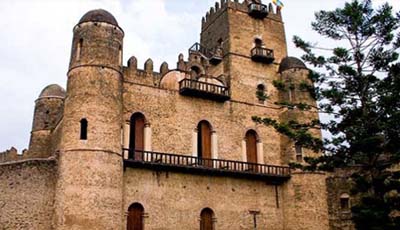
Fasil Ghebbi is located in the Amhara National Regional State, in North Gondar, the serial property consists of eight components. Within the Fasil Ghebbi palace compound are:
- The Castle of Emperor Fasilidas,
- The Castle of Emperor Iyasu,
- The Library and Chancellery of Tsadik Yohannes
- The Castle of Emperor David,
- The Palace of Mentuab
- Banqueting Hall of the Emperor Bekaffa.
The remaining seven components are located in and around the city of Gondar:
- The Debre Berhan Selassie (Monastery and church);
- The Bath of Fasilidas;
- Qusquam (Monastery and Church);
Between the thirteenth and seventeenth centuries, Ethiopian rulers moved their royal camps frequently. King Fasil (Fasilidas) settled in Gondar and established it as a permanent capital in 1636. Before its decline in the late eighteenth century, the royal court had developed from a camp into a fortified compound called Fasil Ghebbi, consisting of six major building complexes and other ancillary buildings, surrounded by a wall 900 metres long, with twelve entrances and three bridges.
HARAR
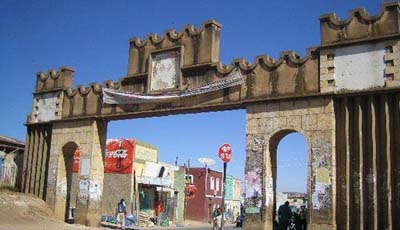
The fortified historic town of Harar is located in the eastern part of Ethiopia, 525 km from the capital of Addis Ababa, on a plateau with deep gorges surrounded by deserts and savannah. The walls surrounding this sacred city, considered “the fourth holy city” of Islam, were built between the 13th and 16th centuries and served as a protective barrier. There were five historic gates, which corresponded to the main roads to the town.Harar Jugol numbers 82 mosques, three of which date from the 10th century, 102 shrines and a number of traditional, Indian and combined townhouses with unique interior designs, which constitute a spectacular part of Harar's cultural heritage.Harar functioned as the capital of the Harari Kingdom from 1520 to 1568, became an independent emirate in the 17th century and was integrated into Ethiopia in 1887. From the late 16th century to the 19th century Harar was an important trade centre between the coast and the interior highlands and a location for Islamic learning.
KONSO
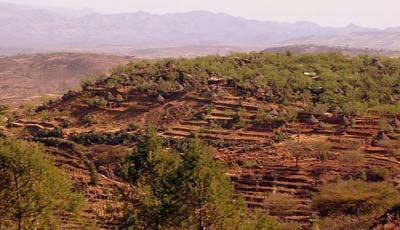
The Konso Cultural Landscape is characterized by extensive dry stone terraces bearing witness to the persistent human struggle to use and harness the hard, dry and rocky environment. The terraces retain the soil from erosion, collect a maximum of water, discharge the excess, and create terraced fields that are used for agriculture. The terraces are the main features of the Konso landscape and the hills are contoured with the dry stone walls, which at places reach up to 5 meters in height.The walled towns and settlements (paletas) of the Konso Cultural Landscape are located on high plains or hill summits selected for their strategic and defensive advantage. These towns are circled by between one and six rounds of dry stone defensive walls, built of locally available rock. The cultural spaces inside the walled towns, called moras, retain an important and central role in the life of the Konso. Some walled towns have as many as 17 moras. The tradition of erecting generation marking stones called daga-hela, quarried, transported and erected through a ritual process, makes the Konso one of the last megalithic people.The traditional forests are used as burial places for ritual leaders and for medicinal purposes. Wooden anthropomorphic statues (waka), carved out of a hard wood and mimicking the deceased, are erected as grave markers. Water reservoirs (harda) located in or near these forests, are communally built and are, like the terraces, maintained by very specific communal social and cultural practices.
LOWER AWASH VALLEY

The Lower Awash Valley paleo-anthropological site is located 300 km northeast of Addis Ababa, in the west of the Afar Depression. It covers an area of around 150 km2.The Awash Valley contains one of the most important groupings of paleontological sites on the African continent. The remains found at the property, the oldest of which date back over 4 million years, provide evidence of human evolution, which has modified our conception of the history of humankind. The most spectacular discovery came in 1974, when 52 fragments of a skeleton enabled the famous Lucy to be reconstructed.Excavations by an international team of palaeontologists and pre-historians began in 1973, and continued annually until 1976, and ended in 1980. In that time, they found a large quantity of fossilised hominid and animal bones in a remarkable state of preservation, the most ancient of which were at least four million years old. In 1974, the valley produced the most complete set of remains of a hominid skeleton, Australopithecus afarensis, nicknamed ‘Lucy’, dating back 3.2 million years. Afarensis has since been proved to be the ancestral origin for both the Genus Australopithecus and Homo-sapiens.A recovered female skeleton nicknamed ‘Ardi’ is 4.4 million years old, some 1.2 million years older than the skeleton of Australopithecus afarensis ‘Lucy’.There is a wealth of paleo-anthropological and pre-historic tools still awaiting discovery and scientific study and these are seen as constituting an exceptionally important cultural heritage resource.
LOWER OMO VALLEY

The Lower Valley of the Omo is located in south-western Ethiopia. It extends over an area of 165 km2. The age old sedimentary deposits in the Lower Omo Valley are now world renowned for the discovery of many hominid fossils, that have been of fundamental importance in the study of human evolution.The Lower Omo Valley includes the Konso and Fejej paleontological research locations with sedimentary deposit going back to the plio-pleistocene period. These have produced numerous hominid and animal fossils, including fragments of Australopithecus. The deposits of human vertebrae fauna, and paleo-environmental evolution, shed light on the earliest stages of the origins and development of Homo sapiens of Africa. The discoveries of ancient stone tools in an encampment also offers evidence of the oldest known technical activities of prehistoric beings, thus making the property one of the most significant for mankind.To ensure Omo’s position as the yardstick against which all other ancient deposits in East Africa are measured, researched evidence from the site has established bio-stratigraphical, radiometric and magneto-stratigraphical scales spanning between one and 3.5 million years.Since 1966, scientific research has proved that the site significantly contributes to prominent archaeological, geological, paleo-anthropological and paleo-environmental studies.
TIYA

Tiya is among the most important of the roughly 160 archaeological sites discovered so far in the Soddo region, south of Addis Ababa. The site contains 36 monuments, including 32 carved stelae covered with symbols, most of which are difficult to decipher. They are the remains of an ancient Ethiopian culture whose age has not yet been precisely determined.Tiya is located in the Ethiopian highlands, about 70 km south of Addis Ababa. It is a place shrouded in mystery, where 36 stone stelae – considered to be representative of similar stelae found elsewhere in the region – stand to attention in an area where tombs are also found. They are assumed to have some kind of funerary significance, but their age and origin is unknown. Most of the stelae, which stand 1-5 m high, are carved with symbols, including depictions of swords and schematic human figures.
SIEMEN MOUNTAINS NATIONAL PARK

No matter how you are look at hem the siemen mountains (will) leave you speech less. This massive 4000m hight fable rock. River wite gulies offers easy bust immensely rewarding. Trekking along the edge of a platue that falls sheer the plains far, far below it’s not just their scenery that will leave you speechless but also the excitement of siting among a group of 100 gelada baboon or watching magnificent walya ibex though on the rock ledges, the mountains are also home to a variety of other endemic mammals, birds and plants. The siemen mountains aren’t to be missed they undoubtedly rank among Africans most beautiful ranges.
THE FINDING OF THE TRUE CROSS (MESKEL)
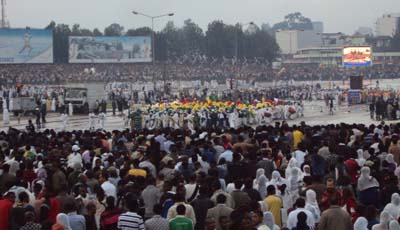
After the Death and Resurrection of Jesus Christ, the cross that he and the other two, have been crucified was buried in a big mountain of rubbish for a long time, Queen Eleni ,as she is known, had a revelation in a dream. She was told that she should make a bonfire and that the smoke would show her where the true cross was buried. So she ordered the people of Jerusalem to bring wood and make a huge pile. This is the story behind why we see a big bonfire installed everywhere in Ethiopia to celebrate meskel fest.Celebrations begin with the building of the Damera bonfire in Maskel Square in Addis Ababa – a conical pyre of poles surrounded by bundles of branches and torches, decorated with green grass and Abyssinian daisies symbolizing the New Year. Hundreds of thousands of people from diverse communities flock to the square as colourfully dressed priests chant hymns and prayers and perform their unique rhythmic dance in front of the pyre. At the climax, the patriarch of the Ethiopian Orthodox Tewahedo Church lights the bonfire. Maskel is celebrated nationwide regardless of age, gender, language or ethnicity. Participants are believIt is a religious holy day for Ethiopian and Eritrean orthodox church, has also a cultural significance for those who have been working or living away from families in rural areas visit their beloved families and spend their time to celebrate with them. Meskel inscribed as the world heritage site by UNESCO IN 2013, it is one of the intangible heritages of Ethiopia
IRREECHA

Irreecha is part of the Gadaa System that served as the basis of democratic and egalitarian political system among the Oromos , a thanksgiving day that comprises two distinct festivals observed on top of mountains and on the banks of rivers, is the most colorful and very attractive celebration the Oromo people mark for the glory of their creator (Waaqa).The Irreecha festival which constitutes the main part of the Gadaa system of the Oromo is serving as a symbol of the Oromo people’s identity from time immemorial. Gadaa is the traditional social stratification system of Oromos in Ethiopia and northern Kenya; it is also practiced by the Gedeo people of southern Ethiopia. The festival which attracts millions of people from all walks of life here and abroad celebrated to thank, bless and pray to God (Waaqa) for their achievements and their wishes for peaceful relationship between nature and man. They plead to God for the health of their families, relatives, clan and their country as well as their livestock.The Oromo people celebrate Irreecha at two locations: at mountain tops (Tulluu) and at the bank of rivers (Malkaa). The observance of the two festivals mark seasonal shift, either from winter to spring or spring to winter.
FICHEE-CHAMBALAALLA

Inscribed in 2015 Fichee-Chambalaalla is a New Year festival celebrated among the Sidama people. According to the oral tradition, Fichee commemorates a Sidama woman who visited her parents and relatives once a year after her marriage, bringing ''buurisame'', a meal prepared from false banana, milk and butter, which was shared with neighbours. Fichee has since become a unifying symbol of the Sidama people. Each year, astrologers determine the correct date for the festival, which is then announced to the clans. Communal events take place throughout the festival, including traditional songs and dances. Every member participates irrespective of age, gender and social status. On the first day, children go from house to house to greet their neighbours, who serve them ''buurisame''. During the festival, clan leaders advise the Sidama people to work hard, respect and support the elders, and abstain from cutting down indigenous trees, begging, indolence, false testimony and theft. The festival therefore enhances equity, good governance, social cohesion, peaceful co-existence and integration among Sidama clans and the diverse ethnic groups in Ethiopia. Parents transmit the tradition to their children orally and through participation in events during the celebration. Women in particular, transfer knowledge and skills associated with hairdressing and preparation of ''buurisame'' to their daughters and other girls in their respective villages.
ASHEND
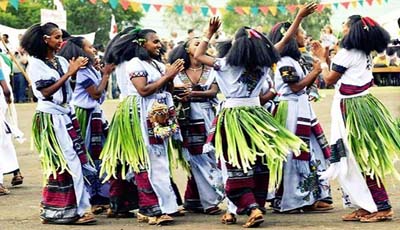
Ashenda is a unique Tigraian traditional festival which takes place in August to mark the ending of fasting called filseta. This event is mostly for girls and young women, which they await very eagerly every year. It is unique to the people in the state of Tigrai in northern Ethiopia. The name of the festival "Ashenda" comes from the name of a tall grass that the girls make in to a skirt and ware it around their waist as a decoration.The young women and girls dress the best traditional dresses called tilfi which is a cotton dress decorated with amazing embroidery from the neck to toe in front of the dress. The girls also adorned themselves with array of beautiful jewelry.After they gather in the village or city center they divide in to small groups and they go house to house singing and playing their drums. They stop at every house and sing and dance for the people in the houses. It is customary for people to give them money, food and drinks and other items for their efforts. They continue the whole day going from house to house and occasionally stopping in a village or city center and singing and dancing for a while before they go on again on their tour.A week or so after the celebrations started, the event comes to an end with all the girls from the village or the town coming together in the center of the town or a village singing and dancing until sun down. This time the young boys join in more like spectators than active players.


